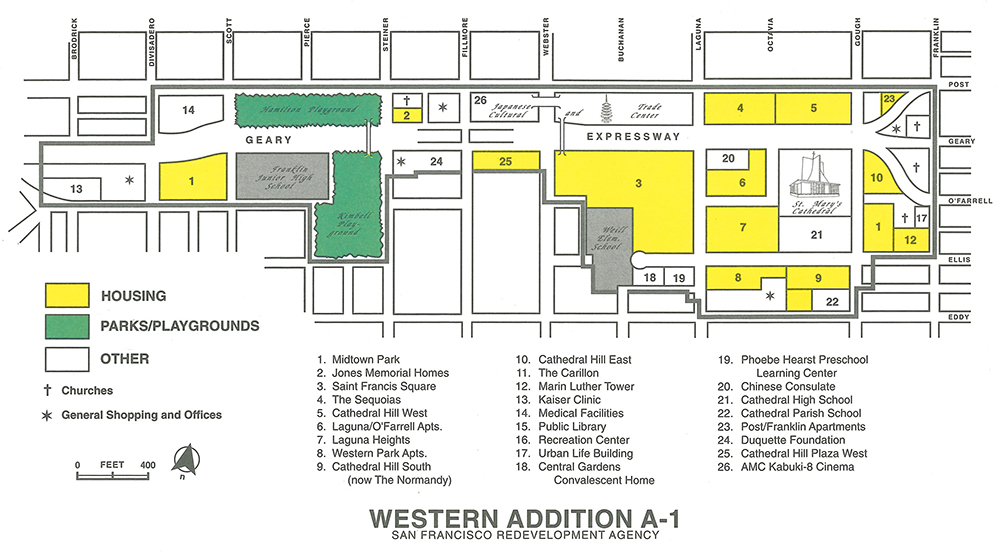Western Addition A-1

Date Established: May 28, 1956
Date Completed: March 1973
Project Area Expiration: May 10, 2000
Project Area Size: 108 acres
REDEVELOPMENT PROGRAM
The Western Addition A-1 Redevelopment Project Area was established in 1956 to eliminate blighting conditions in the area surrounding the intersection of Geary and Fillmore Streets, and to allow for the City of San Francisco’s plans to widen Geary Street into an east-west boulevard. At the time, city leaders favored a boulevard that bypassed, via an underpass, the old Fillmore Street shopping district in favor of a planned shopping center at the peak of Geary Street where a major department store was already established. In addition, the redevelopment program called for the closure of a portion of certain streets (i.e., Octavia, Ellis, Pierce, and O'Farrell streets) and a re-parcelization of properties for redevelopment. The redevelopment program also called for the retention of certain existing uses, including churches, the Buchanan Street YMCA, existing medical offices and facilities, banks, hotels, a used car lot and a supermarket.
Before redevelopment, the project area included 108 acres, of which 37 acres were streets, 13 acres were public parks, schools and institutional uses, 43 acres were residential uses, and 15 acres were commercial and industrial uses. The population was 6,112. After redevelopment, it was envisioned that the residential uses would decrease to 29 acres, the parks, schools and institutional uses would increase to 25 cres, the industrial uses would be eliminated, and the population of the area would decrease to 3,724.
This redevelopment program was outlined in the Redevelopment Plan (“Plan”) approved by the Redevelopment Agency’s Commission on November 23, 1954 and by the San Francisco Board of Supervisors on May 28, 1956. Although the Agency played the lead role in implementing the Plan, various city departments aided and cooperated in this effort.
PROJECT AREA FINANCING
The federal government, through its Urban Renewal Program, funded the redevelopment program for the project area under the U.S. Department of Housing and Urban Development’s (“HUD”) Loan and Grant Contract Program. Under this program, the Agency obtained a temporary loan from the federal government in the estimated amount of about $16.2 million to carry out all activities necessary to implement the Plan. The temporary loan included about $13.3 million in funds to pay fair market value for property acquired by the Agency. The Agency complied with all provisions of law relating to the exercise of the right of eminent domain. The HUD Loan and Grant Contract Program was closed out on March 30, 1973.
IMPLEMENTATION AND RELOCATION
During the implementation phase of the redevelopment plan, the Agency began clearing the areas between Franklin Street on the east, Post Street on the north, St. Joseph’s Avenue on the west, and Eddy Street on the south. The effort required the relocation of 1,350 households and 358 businesses. As a result, city leaders opened a relocation assistance office in February 1958 in the YMCA/YWCA building because it was centrally located and represented “a symbol of service” to the social needs of the community.
The relocation efforts, however, disrupted the community to the point that a community organization called Western Addition Community Organization (“WACO”) was formed and subsequently filed a lawsuit against the Agency’s activities. The success of the lawsuit caused a change in federal law on how redevelopment agencies were to implement their programs. By 1970, the U.S. Congress eventually passed the Uniform Relocation Act which set the stage for more orderly and open redevelopment activities and provided for an increase in relocation benefits for residents, property owners and businesses.
The Final Relocation Report on the Western Addition A-1 dated July 25, 1963 concluded that: “While the re-housing record for the Western Addition A-1 is frequently described as unsatisfactory by individuals and groups who are concerned with housing opportunities for minorities and poor families and individuals, there is inadequate awareness of the fact that the great majority of the affected families, individuals, businesses and institutions clearly and unmistakably improved their status. Despite the many problems encountered and notwithstanding the absence of new legal and fiscal devices to facilitate the creation of new housing until the Housing Act of 1961, the Agency’s goal of satisfactory housing for all displaced residents, though not completely realized, was approached. Two out of three of the residents moved into standard housing and three out of four bettered their condition.”
REDEVELOPMENT RESULTS
The bulk of the redevelopment work was completed by March 1973, nearly 20 years after the project area was formed. Geary Street was widened and turned into an expressway, two existing public schools and three existing private schools were remodeled and expanded, a new post office and new medical facilities were built, a branch of the public library was expanded, several existing churches were expanded and a new landmark church (St. Mary’s Cathedral) was built.
In addition, the redevelopment effort included the construction of the Japanese Cultural and Trade Center, a focal point for Japanese cultural activities in San Francisco. Completed in 1968, the center includes a major commercial complex, an eight-screen movie theater, a hotel and the Japan Cultural Center’s Peace Plaza and Peace Pagoda. Various ethnic cultural activities and celebrations are held in Peace Plaza throughout the year.
In terms of residential units, the Agency's redevelopment effort in the project area produced: (1) 2,009 units of new housing, of which 33% were federally subsidized for low- and moderate-income households; (2) 162 units of new housing constructed under Owner Participation Agreements, and (3) 226 units of rehabilitated housing.
Sources:
(1) A Final Report on the Western Addition, A-1 Approved Redevelopment Project Area; prepared by the Redevelopment Agency of the City and County of San Francisco; April 2000
(2) Memorandum to the Agency Commission dated April 25, 2000